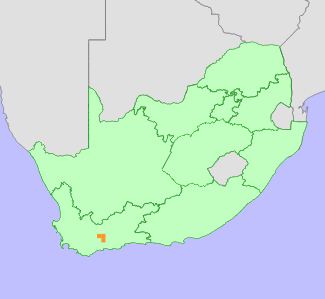|
Scientific Name | Conophytum piluliforme (N.E.Br.) N.E.Br. subsp. edwardii (Schwantes) S.A.Hammer |
Higher Classification | Dicotyledons |
Family | AIZOACEAE |
Synonyms | Conophytum edwardii Schwantes, Conophytum rubrum L.Bolus |
National Status |
Status and Criteria | Critically Endangered A3cd |
Assessment Date | 2021/12/01 |
Assessor(s) | A.J. Young, P.G. Desmet, I. Ebrahim, D. Guo, A. Harrower, L. Jabar, L. Knoetze, C. Rodgerson, P.C.V. Van Wyk & N.N. Mhlongo |
Justification | This succulent is endemic to the Western Cape of South Africa, with an extent of occurrence (EOO) 81 km2, and an area of occupancy (AOO) of 16 km2. Anthropogenic climate change is a major threat to this taxon. Loss of vegetation cover has been observed at this site via Landsat imagery between 1984 and 2018 and is used to infer that the habitat quality is already in decline. Modelling of climate change impacts is predicted to result in an average loss of 99% of suitable bio-climatic habitat by 2080 (three generations; 60 years) under likely CO2 emission scenarios (RCP 2.6). Illegal collection is also likely to contribute to future population decline. It therefore qualifies as Critically Endangered under criterion A3. |
Distribution |
Endemism | South African endemic |
Provincial distribution | Western Cape |
Range | This succulent is endemic to the Western Cape of South Africa. |
Habitat and Ecology |
Major system | Terrestrial |
Major habitats | Little Karoo Quartz Vygieveld |
Description | This succulent is endemic to the Rainshadow Valley Karoo bioregion of the Succulent Karoo bioregion. The plants inhabit small areas of shale often covered with small quartzite stones. This taxon has a generation length of 20 years. It is expected to be sensitive to the impacts of climate change as it does not disperse and while adapted to arid conditions, is dependent on limited seasonal rainfall. Species in the genus are sensitive to long periods of drought. Drought related mortality has been observed for other closely related taxa within the genus. |
Threats |
| This particular succulent is not currently threatened by illegal collection but it is likely that it will become a target in coming years as there has been a dramatic increase in the number of species and volume of plants of this genus targeted since 2019.
Loss of vegetation cover has been observed across its range via Landsat imagery between 1984 and 2018 indicating a decline in habitat quality. While it is not possible to model the response of this taxon to climate change due to its restricted distribution, the average loss to climate change for two more widely distributed Conophytum species occurring within the same region is used as an indication of likely impact to this taxon. Climate models for the likely emission scenarios where emissions stay at present day levels (RCP 2.6) (Hausfather and Peters 2020) and worst case scenarios where emissions continue to increase during the 21st century (RCP 8.5) indicate that there will be a loss of suitable bioclimatic envelope of between 99% and 100% by 2080 for Conophytum taxa within the region. Species in this genus have limited dispersal ability and migration to suitable habitats elsewhere is regarded as highly unlikely. |
Population |
There are no formal estimates of population size for this taxon but there are thought to be between 5,000 and 15,000 mature individuals. The number of plants in this general area have been in decline in recent years due to an extended drought and the population may be in decline.
|
Population trend | Unknown |
Assessment History |
Taxon assessed |
Status and Criteria |
Citation/Red List version | | Conophytum piluliforme (N.E.Br.) N.E.Br. subsp. edwardii (Schwantes) S.A.Hammer | Rare | Raimondo et al. (2009) | |
Bibliography |
Hammer, S. 2002. Dumpling and his wife: New view of the genus Conophytum. EAE Creative Colour, Norwich.
Hammer, S.A. 1993. The genus Conophytum: A conograph. Succulent Plant Publications, Pretoria.
Hausfather, Z. and Peters, G.P. 2020. Emissions - the 'business as usual' story is misleading. Nature 577(618-620).
Opel, M.R. 2004. The rediscovery of Crassula alcicornis. Haseltonia 10:38-40.
|
Citation |
| Young, A.J., Desmet, P.G., Ebrahim, I., Guo, D., Harrower, A., Jabar, L., Knoetze, L., Rodgerson, C., Van Wyk, P.C.V. & Mhlongo, N.N. 2021. Conophytum piluliforme (N.E.Br.) N.E.Br. subsp. edwardii (Schwantes) S.A.Hammer. National Assessment: Red List of South African Plants version 2024.1. Accessed on 2025/11/07 |
 Comment on this assessment
Comment on this assessment


